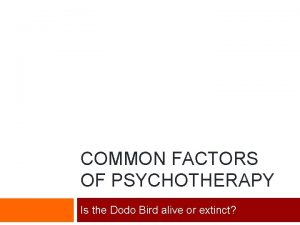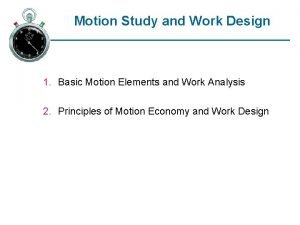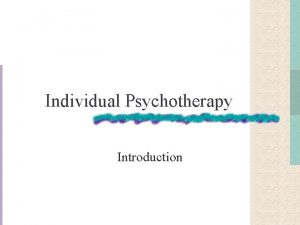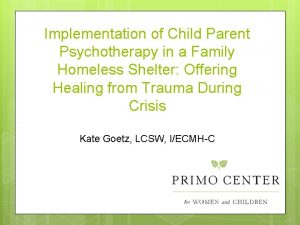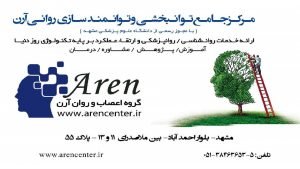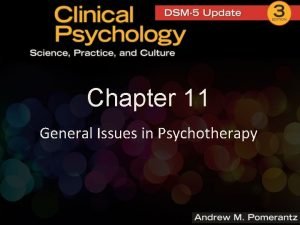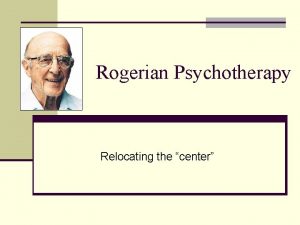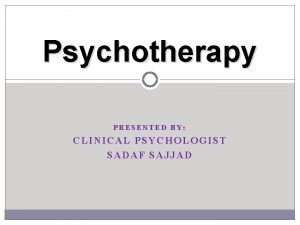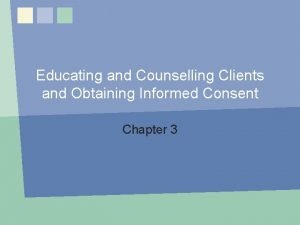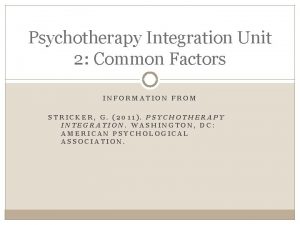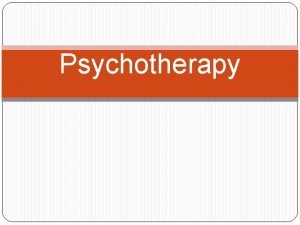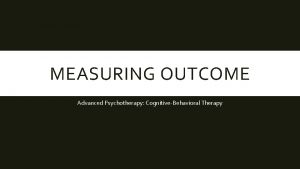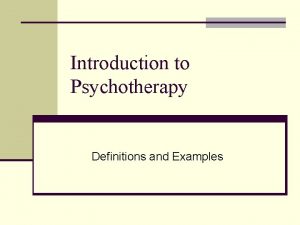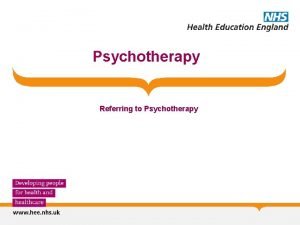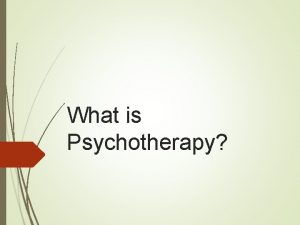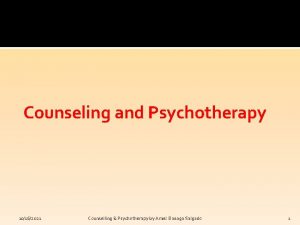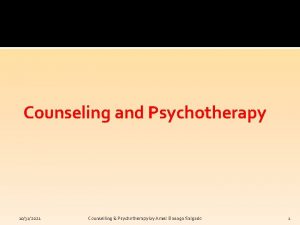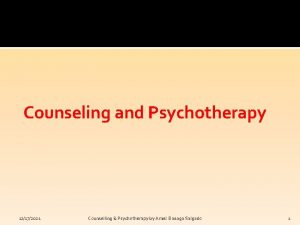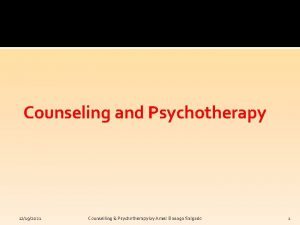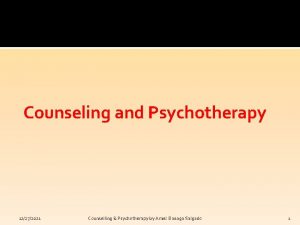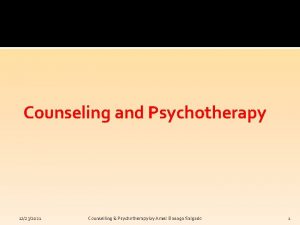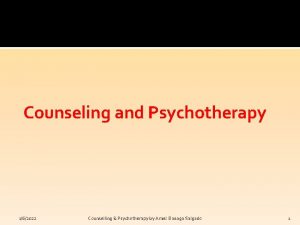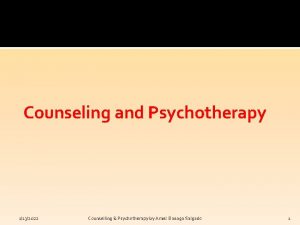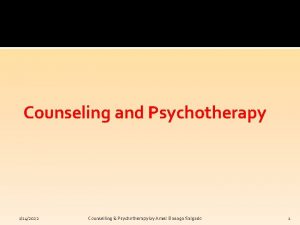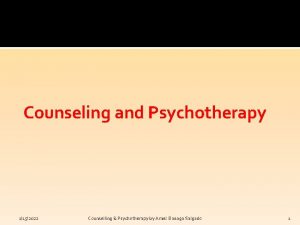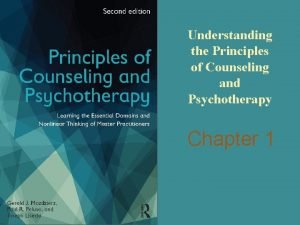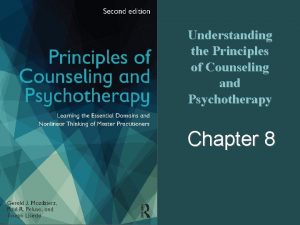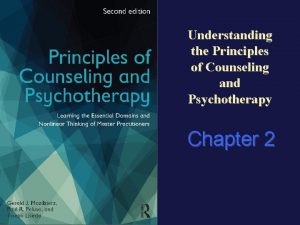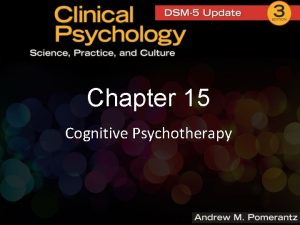Understanding the Principles of Counseling and Psychotherapy Chapter




















- Slides: 20

Understanding the Principles of Counseling and Psychotherapy Chapter 12

Chapter 12 Overview Odysseus’s Dilemmas Ambivalence Defined Listening for Ambivalence Flight into Illness/Health Secondary Gains Resistance/Reactance

Odysseus’s Dilemma The Sirens –Wanting to have his cake and eat it too! Scylla and Charybdis –Stuck between a rock and a hard place! How to get out? Non-Linear Thinking! –Feel pulled in both directions at the same time!

Definition of Ambivalence Coined in 1911 by Bleuler A symptom of schizophrenia “Ambi” = “Both” or “in two ways” (Lat. ) “Valence” = “powerful attraction towards a goal” (Lat. )

Definition of Ambivalence Client’s experience–Feels stuck between a rock and a hard place, –Because he wants to have his cake and eat it too, –And he feels pulled in two directions. Clash between schema dynamics and demands of life/dealing with circumstances –Recall coping and appraisal?

Please turn to p. 290, Clinical Case Example: Stuck in a Loveless Marriage

Types of Ambivalence Lewin’s “Force Field” theory Recognizes “double binds” Poles “pull” in different directions Four types of “conflict” that result in ambivalence

4 Types of Conflict Approach-Approach Conflict –“Buyer’s remorse” Avoidance-Avoidance Conflict –Neither option looks good Approach-Avoidance Conflict –The only option has good and bad consequences Double Approach-Avoidance Conflict –Both options have good and bad consequences

Dollard and Miller What do rats (people) do in these “conflicts”? 1. Become immobilized 2. Vacillate endlessly 3. Try to escape or avoid 4. Let “Fate” decide This is where clients enter therapy Please turn to p. 297, Clinical Case Example: Ambivalence and Life or Death

Linear and Non-Linear Views of Ambivalence Linear- Client is resistant, oppositional-defiant, etc. –Ambivalence must be overpowered/overcome! Non-Linear- Ambivalence is part of the change process –There is a cost to the client! –Clients must “work through” the ambivalence to make change work (I. e. , second order change). Please turn to p. 301, Domain 6 Nonlinear Thinking Exercise – Buridan’s Donkey & Bridge

Listening and Recognizing Ambivalence Non-Linear Listening Congruence- Inference. Absence. Presence. Resistance. All indicate a client’s endless vacillation, becoming paralyzed, giving up, or letting fate decide!

Listening and Recognizing Ambivalence Emotions and Emotional Reaction Stages of Change

Flight into Illness/Flight into Health Flight into Illness Symptoms appear in order to help a client avoid making a decision or taking action Physical symptoms must be treated carefully, however!!!! (Please turn to p. 310, Clinical Case Example: Flight into Illness)

Flight into Illness/Flight into Health Symptoms disappear in order to help a client avoid addressing the underlying problem or making a change in therapy The problem doesn’t really change, however!!!

Flight into Illness/Flight into Health KEY: Understanding that the ambivalence is based on the client’s skewed perception that their symptom/problem is USEFUL to the client, even if it is destructive!

Secondary Gain Flight into Illness/Flight into Health have Primary Gain –Client gets a direct benefit from behavior Secondary Gain- benefit is not immediately detectable –Much more powerful influence, difficult to give up Psychodynamic- Beh. Is self-protecting Behavioral- Beh. Is self-reinforcing Client reasons are hidden, need non-linear approach to understand, then help client work through!

Double Binds (revisited) Requires 2+ people One person as victim, one as the superior Series of Injunctions are placed on the recipient (victim) Primary injunction formats: a. “Do (some behavior) or I will punish you” b. “Do not do (some behavior) or I will punish you” c. (or both a & b) Punishment may include withdrawal of love, expression of hate/anger, or abandonment.

Double Binds (revisited) Secondary Injunction: “Do notice the contradiction between my claim to be a loving parent and my willingness to withdraw my love from you. ” “Do notice or comment on the unfairness of this situation” “Do not question my love” “You must do X, but only do it because you want to. ” Tertiary. Injunction: May include reversals (promises to be better; threats of harm to the recipient, the superior, or some one else the victim cares about)

Double Binds (revisited) Schema Dynamics may form the secondary injunction Client expressions of stress may reveal ambivalence that is a sign the client may be in a double bind This may produce ambivalence not only to resolving the client’s problems, and subsequently to obtaining help through therapy

THANK YOU. Any Questions?
 Differentiate between guidance and counselling
Differentiate between guidance and counselling Common factors psychotherapy
Common factors psychotherapy Doctorate in counselling psychology
Doctorate in counselling psychology Principles of motion study
Principles of motion study Ranzcp psychotherapy written case
Ranzcp psychotherapy written case Cognitive therapy ap psychology
Cognitive therapy ap psychology Re-educative individual psychotherapy
Re-educative individual psychotherapy Cpp triangle of explanation
Cpp triangle of explanation Introduction to psychotherapy ppt
Introduction to psychotherapy ppt Bracketing in psychotherapy
Bracketing in psychotherapy General issues in psychotherapy
General issues in psychotherapy 19 propositions rogers
19 propositions rogers Psychotherapy refers to
Psychotherapy refers to Psychotherapy definition
Psychotherapy definition Individual psychotherapy definition
Individual psychotherapy definition Quantum psychotherapy
Quantum psychotherapy Cognitive disputation
Cognitive disputation The common factors approach to psychotherapy integration
The common factors approach to psychotherapy integration Types of psychotherapy
Types of psychotherapy Advanced psychotherapy
Advanced psychotherapy Psychotherapy examples
Psychotherapy examples

